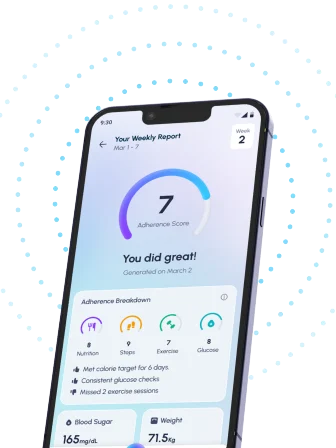Table of Contents
- Understanding Stroke Risk Factors in Diabetes
- Diabetes and Stroke: Recognizing the Warning Signs
- Preventing Stroke: A Guide for Diabetic Patients
- Ischemic vs. Hemorrhagic Stroke: What’s the Difference?
- Managing Diabetes to Reduce Stroke Risk
- Frequently Asked Questions
- References
Living with diabetes means being extra vigilant about your health, and understanding your risk for serious complications is crucial. One significant concern for many diabetics is stroke. This guide, Understanding Stroke Risk: A Diabetes Patient’s Guide to Symptoms and Causes, is designed to empower you with the knowledge you need to protect yourself. We’ll explore the connection between diabetes and stroke, delve into the common warning signs, and discuss the underlying causes so you can take proactive steps towards prevention. Let’s work together to keep you healthy and informed.
Understanding Stroke Risk Factors in Diabetes
Diabetes significantly increases your risk of stroke, a life-threatening condition affecting blood flow to the brain. This risk is amplified in tropical and Indian climates, often due to factors like high humidity and increased exposure to heat, which can exacerbate underlying health conditions. Understanding these risk factors is crucial for prevention and timely intervention.
High Blood Sugar and Blood Vessel Damage
High blood glucose levels, characteristic of diabetes, damage blood vessels over time. This damage, known as atherosclerosis, leads to the narrowing and hardening of arteries, reducing blood flow. This process is accelerated in individuals who also smoke. Research shows that smokers with diabetes face double the mortality rate from cardiovascular issues, including stroke. Managing your blood sugar levels through diet, exercise, and medication is paramount. To learn more about the specific impact of diabetes on blood flow, read our article on How Does Diabetes Affect Blood Flow?.
Other Contributing Factors
Beyond high blood sugar, several other factors increase stroke risk in diabetics. These include high blood pressure (hypertension), high cholesterol, obesity, physical inactivity, and a family history of stroke. In tropical regions, factors like heat stroke and dehydration can also further increase the risk. Regular health check-ups, including blood pressure and cholesterol monitoring, are essential.
Taking Control of Your Risk
Adopting a healthy lifestyle is key to mitigating stroke risk. This includes a balanced diet rich in fruits and vegetables, regular exercise, maintaining a healthy weight, and quitting smoking. Seeking advice from your doctor or a qualified healthcare professional is crucial for developing a personalized management plan. In India and other tropical countries, be especially mindful of hydration and avoiding extreme heat. Early detection and treatment are crucial in managing diabetes and preventing life-threatening complications like stroke. For more information on the vital role of diet in preventing and managing stroke, see The Role of Diet in Preventing and Managing Stroke – Tap Health.
Diabetes and Stroke: Recognizing the Warning Signs
Diabetes significantly increases your risk of stroke, a life-threatening condition affecting blood supply to the brain. This risk is heightened in individuals aged 20-64, representing 61% of people with diabetes globally, according to the International Diabetes Federation, as well as in the older population (39% aged 65+). Understanding the warning signs is crucial for prompt medical intervention, especially in high-risk regions like India and other tropical countries where access to healthcare might be limited.
Recognizing Stroke Symptoms
Time is brain when it comes to stroke. Immediate action is vital. Common stroke symptoms include sudden numbness or weakness in the face, arm, or leg (especially on one side of the body), confusion, trouble speaking or understanding speech, difficulty seeing, dizziness, loss of balance or coordination, and severe headache with no known cause. These symptoms can manifest subtly, particularly in individuals with pre-existing conditions like diabetes. In tropical climates, dehydration can exacerbate these issues, making it even more crucial to stay hydrated and monitor for changes in your health.
Diabetes-Specific Considerations
Individuals with diabetes often experience subtle or atypical stroke symptoms, making early detection challenging. High blood sugar levels can mask or mimic some stroke symptoms, delaying diagnosis and treatment. Regular blood sugar monitoring, along with adherence to prescribed medication and lifestyle changes, is critical in mitigating this risk. It’s vital to seek immediate medical attention if you experience any of the symptoms mentioned above, even if they seem mild or transient. Learning about the 10 Early Signs and Symptoms of Diabetes can help with early detection and management.
Taking Action
If you, or someone you know, experiences any of these symptoms, seek immediate medical assistance. In India and other tropical countries, awareness campaigns and readily accessible healthcare information are crucial in combating the high incidence of stroke among diabetics. Early diagnosis and treatment significantly improve the chances of recovery and a better quality of life. Don’t delay – your health depends on it. For those managing diabetes, understanding the challenges and solutions associated with aging and diabetes is also crucial.
Preventing Stroke: A Guide for Diabetic Patients
Diabetes significantly increases your risk of stroke, a life-threatening condition affecting blood flow to the brain. This risk is heightened in individuals living in hot and humid climates like those prevalent across India and other tropical countries, where factors like dehydration and heat stress can further compromise cardiovascular health. Understanding and managing your diabetes is crucial in stroke prevention.
Managing Blood Sugar Levels
Maintaining stable blood glucose levels is paramount. Regular blood sugar monitoring, coupled with a balanced diet rich in fruits, vegetables, and whole grains, is essential. Limiting processed foods, sugary drinks, and saturated fats is vital. Consult your doctor or a registered dietitian for a personalized dietary plan suitable for your needs and the tropical climate you live in. Remember, consistent blood sugar control minimizes the damage to your blood vessels, a major stroke risk factor.
Controlling Blood Pressure and Cholesterol
High blood pressure (hypertension) and high cholesterol are major contributors to stroke. Regular check-ups to monitor these levels are crucial. Your doctor may prescribe medication to manage these conditions effectively. Lifestyle modifications, such as regular exercise and stress reduction techniques like yoga or meditation, can also significantly contribute to better cardiovascular health.
Addressing Kidney Health
Diabetes increases the risk of kidney disease, with nearly 30% of diabetics developing diabetic nephropathy. Protecting your kidneys is vital in reducing stroke risk. Regular kidney function tests, adhering to prescribed medications, and maintaining a healthy lifestyle are essential. Early detection and management of kidney complications can greatly improve your overall health and reduce stroke risk. For more information on preventing long-term complications, see our guide on How to Prevent Long-Term Complications of Diabetes: Easy Tips.
Lifestyle Changes for Stroke Prevention
Incorporating regular physical activity, quitting smoking, and limiting alcohol consumption are crucial lifestyle adjustments. These changes, along with diligent management of your diabetes, can significantly reduce your risk of stroke and improve your quality of life. Regular check-ups and open communication with your healthcare provider are key to preventing strokes and managing your diabetes effectively. Consult your doctor today to discuss a personalized prevention plan tailored to your specific needs and the climate you live in. Remember that protecting your heart is also crucial; read more about it in Protect Your Heart from Diabetes: 5 Essential Steps.
Ischemic vs. Hemorrhagic Stroke: What’s the Difference?
Understanding the type of stroke is crucial for effective treatment. There are two main types: ischemic and hemorrhagic. Ischemic strokes, the most common, occur when a blood clot blocks blood flow to part of the brain. Think of it like a clogged pipe—the brain isn’t receiving the oxygen and nutrients it needs. Risk factors significantly increase for individuals with diabetes, especially considering that over 60% of people with diabetes in India also have hypertension, a major contributor to stroke. This high prevalence highlights the critical need for awareness and proactive health management in India and other tropical countries. For example, understanding the procedures like Angiogram vs Angioplasty can be helpful in certain stroke related treatments.
Identifying the Difference
Hemorrhagic strokes, on the other hand, happen when a blood vessel in the brain bursts, causing bleeding. This can be due to high blood pressure, aneurysms, or other vascular issues. The symptoms can overlap, making diagnosis challenging. Early recognition is key, as different stroke types require different treatments. For example, ischemic strokes may benefit from clot-busting medications, while hemorrhagic strokes require managing the bleeding.
Knowing Your Risk
For individuals with diabetes in India and similar regions, the risk of both types of stroke is heightened by the prevalence of hypertension. Managing blood sugar and blood pressure effectively is paramount to reducing this risk. Regular check-ups, a healthy diet, and a consistent exercise routine are crucial steps to protect your brain health. It’s also important to understand how conditions like diabetes can impact other aspects of your health. For instance, you may find our article on Does Diabetes Cause Tachycardia? informative. Consult your doctor to discuss personalized strategies for stroke prevention and management. Your proactive approach can significantly impact your long-term health and well-being.
Managing Diabetes to Reduce Stroke Risk
Diabetes significantly increases your risk of stroke, a life-threatening condition affecting the brain’s blood supply. This risk is particularly heightened in women, who have a 40% higher risk of heart disease compared to men with diabetes, according to research. This underscores the critical need for proactive diabetes management in India and tropical countries where diabetes prevalence is unfortunately high.
Understanding Your Risk Factors
Several factors contribute to stroke risk in individuals with diabetes. Poorly controlled blood sugar levels damage blood vessels over time, increasing the chance of blood clots forming and blocking blood flow to the brain. High blood pressure (hypertension), another common complication of diabetes, further exacerbates this risk. Similarly, high cholesterol levels thicken the blood, making it more likely to clot. Maintaining a healthy weight and engaging in regular physical activity are crucial to mitigating these factors. Managing cholesterol is especially important; learn more about how to do this effectively by reading our guide on How to Manage Cholesterol Levels with Diabetes?
Actionable Steps for Prevention
Effective diabetes management is the cornerstone of stroke prevention. This involves regular monitoring of your blood sugar levels, adhering strictly to your prescribed medication, and maintaining a healthy diet. Prioritize a balanced diet rich in fruits, vegetables, and whole grains while limiting processed foods, sugary drinks, and saturated fats. Regular exercise, at least 30 minutes most days of the week, is also vital in managing weight and improving cardiovascular health. Consult your doctor or a certified diabetes educator for personalized advice and support tailored to your specific needs and regional context. Remember, early detection and proactive management are key to preventing a stroke. Regular check-ups with your doctor, including blood pressure and cholesterol monitoring, are essential. For more tips on effective diabetes management, check out our article: 10 Proven Tips for Effective Diabetes Management.
Seeking Support in India and Tropical Countries
In India and other tropical regions, access to quality healthcare and diabetes education varies. Actively seek out local support groups and resources to learn more about managing your diabetes and reducing your stroke risk. These resources can provide invaluable support and guidance in navigating the challenges of diabetes management within your specific community.
Frequently Asked Questions on Stroke Risk in Diabetes
Q1. How does diabetes increase my risk of stroke?
Diabetes damages blood vessels, leading to reduced blood flow and the buildup of plaque (atherosclerosis). This is further worsened by factors like high blood pressure, high cholesterol, and smoking, increasing your chances of a stroke.
Q2. What are the signs and symptoms of a stroke, especially for someone with diabetes?
Stroke symptoms can be subtle in diabetics. Watch for sudden numbness or weakness (especially on one side of the body), confusion, severe headache, or difficulty speaking. Immediate medical attention is crucial if you experience any of these.
Q3. What steps can I take to reduce my risk of stroke if I have diabetes?
Focus on managing your blood sugar through diet, exercise, and medication. Control your blood pressure and cholesterol levels. Maintain a healthy weight and lifestyle. Regular check-ups with your doctor are essential.
Q4. Does living in a hot and humid climate affect my stroke risk?
Yes, heat and humidity can worsen the effects of diabetes, increasing stroke risk. Take extra precautions to stay cool and hydrated, especially during hot weather.
Q5. What should I do if I think I’m having a stroke?
Seek immediate medical attention. Stroke is a time-critical emergency, and prompt treatment can significantly improve outcomes.
References
- A Practical Guide to Integrated Type 2 Diabetes Care: https://www.hse.ie/eng/services/list/2/primarycare/east-coast-diabetes-service/management-of-type-2-diabetes/diabetes-and-pregnancy/icgp-guide-to-integrated-type-2.pdf
- Your Guide to Diabetes: Type 1 and Type 2: https://www.niddk.nih.gov/-/media/Files/Diabetes/YourGuide2Diabetes_508.pdf




